
the cornucopia
olympus M1 to E-1: a remarkable journey
copyright the olympus circle/john foster

the cornucopia olympus M1 to E-1: a remarkable journey copyright the olympus circle/john foster |
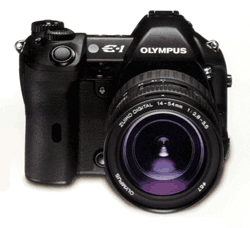
Standard contemporary press release image |
INTRODUCTION: As Editor of Quest, the Magazine of The Olympus Circle, it falls to me to write an article for each issue. This is from Quest 2, December 2003 and compares and contrasts the 1972 Olympus M1 with the new E-1 announced in 2003. ~~~~~ Early in 2003 Olympus announced their first true SLR digital camera. It is now available in the UK and has been enthusiastically reviewed by several journals and magazines. Its announcement has been much lauded and is being compared to the introduction of the M (OM) system back in 1972. If true this new camera could shape the future for Olympus Japan in much the same way as the development of the viewfinder Pen from 1959 to 1971 which then took the company’s stellar designer to what some would say his greatest achievement – OM. Does the choice of E1 as a designation subtlety underline the aspirations borne by the new product? If this is indeed a truly momentous event it seems churlish not to devote this quarters Centrepiece to both the E1 and M1, cameras now separated by 31 years of technological advances, and perhaps reach a view as to the E1’s likely worthiness to assume the mantle of OM. However, is it right to think that this is corporate intent? Might this just be a consequence of development that is inevitable? The OM system was deleted from the company’s products in 2002 and production of silver halide cameras now rests in the development of various compact ranges including the very capable Mju series. The oddly named ‘OM’ 2000, a camera not made by Olympus but badged by the company, was no contender for the mantle of true OM, and its short-lived production ceased in 2001. From the apparent reluctance to develop a competitive auto-focus SLR in the late 80’s and rumours of OM5 to the first whispers that OM was to be phased out, many commentators believed Olympus had lost its way. Whether this is connected to the retirement of Yoshihisa Maitani in the early 90’s is a matter for conjecture, but the camera division of the company seemed rudderless for quite some time. Of course this might be due to a whole host of other issues like the development costs, world recession, competition etc., the self same set of challenges the company presented Mr Maitani in 1959. | |
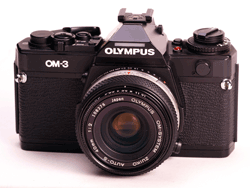
The original mechanical OM3 - not 3Ti |
I think it fair to say that from around 1996 corporate thoughts on further development of a silver halide SLR system camera ceased. Why? No doubt the lack of will to embrace SLR auto-focus lens technology played a big role leaving Olympus with considerable ground to make up on its competitors. And of course the realisation that the first stirrings of the digital revolution might threaten silver halide must have played a part in boardroom decisions. Olympus pursued the new digital technology by developing the Camedia range but perhaps was unsure just where silver halide would end up in the future pecking order. Having said this the company gave us the opportunity to support OM by introducing the OM3Ti with its superb 35-80mm x 2.8 Zuiko zoom said by many to be one of the finest lenses ever made. Looking back there is little doubt the latter years at Olympus Camera Division seem to be filled with both contradiction and inscrutability. In drawing a conclusion it seems pretty obvious to me where Olympus thinks the future lies and silver halide is not (technologically or developmentally) on top. It would be unkind to think of ‘eggs and baskets’ and in many ways the company is hedging its bets. But the strategy is now clear: silver halide = compact 35mm, mass digital = compact Camedia and professional SLR development = high investment digital. Having reached this conclusion we can now see just how important the introduction of the E1 is to the company and from whence stem the lines of comparison to OM system. | |
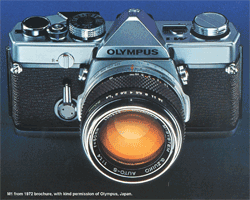
M1 from 1972 glossy brochure |
The illustrations herein are taken from contemporary advertising literature, the M1 from a 1972 brochure and the E1 from a 2003 brochure and serve as a starting point for our discussion. It is not the intention to compare the merits of each camera as we are not comparing like with like in the technological sense. It is probably more interesting to examine the similarities in the statements and promises made for each groundbreaking picture-taking machine with over three decades between them. But as both serve the ultimate objective of recording an image there are bound to be areas of design and function that will have changed little. It is interesting to note both model designations follow the same basic format, letter dash number in very similar style, and it would be gratifying to think someone planned it this way. | |
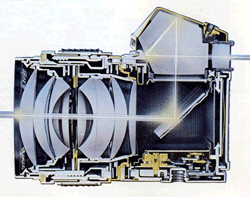
M1 vertical cut-away |
The M1 brochure begins ‘The Olympus M1 is what happens when an entirely fresh concept in 35mm SLR system photography is backed up by one of the worlds leading all-round optical manufacturers.’ The E1 brochure begins ‘To date digital photography with professional SLR cameras has been a compromise between digital image recording and lenses designed for 35mm cameras.’ Both underline the importance of lens design and manufacture. Lenses designed for the E1 are designated Zuiko Digital. It is nice to see the famous Zuiko name lives on, now gracing a new generation of lenses. The original Zuiko SLR lens, says the M1 brochure, ‘features superb resolution, light weight and small size and Olympus experience in precision optical technology and design minimises size and weight.’ | |
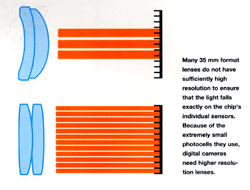
Schematic showing perpendicular light path from ZD lenses |
Of the Zuiko Digital the E1 brochure says ‘downsizing means that the entire lens can be radically reduced in size and will give users more flexibility when shooting in low-light conditions.’ The new Digital Zuiko is specially designed for digital applications allowing light to strike the image sensor at a near-perpendicular angle, minimizing degradation and light loss, even in the image periphery or when using a wide-angle lens. | |
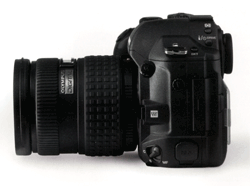
E1 side view |
Not surprisingly the M1 proudly talks of the miniaturisation of its body ‘by 5 years of research into design and function, trimming useless bulk and increasing structural features.’ The E1 is a little more modest claiming a ‘light and strong splash-proof magnesium alloy body.’ Comparison shows the M1 with standard lens weighs in at 660gm, the E1 minus lens, batteries and CF card registers exactly the same - 660gm. In terms of size the M1 is 136 x 86 x 81mm, the E1 is 141 x 104 x 81mm, 20% more volume. | |
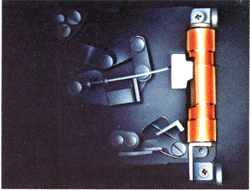
M1 fully damped shutter mechanism |
One of the central advantages the M1 displayed was that of vastly reduced noise and vibration from mirror and shutter mechanisms, a major criticism of all contemporary 35mm cameras. Anyone who has used an early to mid seventies non-Olympus SLR will know the problem, a resounding ‘kerrplunkkk’ and the disconcerting feeling that the shot you’ve just taken is spoiled by camera shake. Mr Maitani addressed this problem by designing the M1 from the ground up rather than taking existing mechanical solutions and modifying them. He looked at the whole concept of the 35mm SLR and tried many solutions to problems before being satisfied. He first turned his mind to his ambition of a full-frame 35mm SLR in 1966 and 6 years in development underlines just how enormous the task. A brand new shutter and oversize mirror box was conceived with air damping, new curtain drums, mirror lock and a new standard in field of view of 97% that almost reaches today’s WYSIWYG boasts.The E1 has a different set of problems to overcome though addressing the same basic issue – more accurate image capture. A major concern with all SLR’s is that of dust entering the body cavity when lenses are changed. The conventional SLR relies on the user to keep screen and mirror clean with soft brushes and blowers. Because the digital SLR uses a highly sensitive CCD to capture the image the pixels are open to contamination causing image deterioration or pixel failure. Previous cleaning methods are too crude. So Olympus has developed a membrane (Anti-Dust Function) that is self-cleaning (Supersonic Wave Filter - SSWF) to protect the CCD. Basically the membrane collects the dust and the SSWF twangs the membrane and the dust falls away. It is obviously far more complex than this and relies on hermetic seals and ultrasonic waves, but that’s the general principle. In addition the bright, easy-to-see viewfinder satisfies the demands of the professional photographer with a field of view that is 100% of the imaging area. Both M1 and E1 refer to their inherent ruggedness and the 1972 literature tells us ‘reliability is provided by the rigorous 100,000-time testing of the cameras vital shutter, winding and mirror mechanisms’. The E1 boasts ‘a durable shutter that can stand up to 150,000 snaps’ [snaps being the activation of shutter in anti-dust mode]. On the face of it, as system cameras, the M1 and E1 seem miles apart, though this deserves further consideration. The single page from E1 brochure shows the system, comprehensive yes but nowhere near the 280+ M1 system. In fact my scanner bed is not large enough to reproduce the M system diagram in full. | |
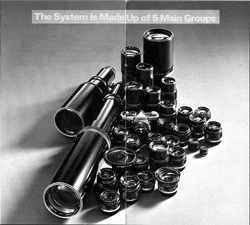
M1 lens system in 1972 |
But there is more to it than pure numbers. Lenses in the M system sported 30 ranged from 8mm to 1000mm with a good selection of specialised macro optics. E system lens range appears modest but they are a different animal altogether. Taking the 35mm equivalent the range is between 28mm and 600mm, most of which is achieved through zooms. Two are fixed lengths, the Macro at 100mm equivalent and the 600mm equivalent. But lens design has certainly moved on in three decades and this new generation boast much brighter apertures in the zooms than some or most of the M System fixed focal lengths. All but the ‘standard’ zoom use some ED elements and their construction is impressive with the equivalent 100~400mm zoom being 16 elements in 15 groups including 3 ED elements and maximum aperture is:- wide-angle end f=2.8, telephoto end f=3.5. [If designated by the element count this would be a P Zuiko!] | |
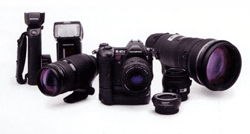
E1 date of release system - sparse! |
Even allowing for the (assumed) loss of a stop by using the 1.4 x tele-converter on the 600mm equivalent this reaches equivalent of 840mm. This takes no account of the digital zooming built into the cameras firmware. The extension tube will enhance the capabilities of the Macro. Zuiko digital lenses are different by their very nature. With downsizing and designing for a new concept of image capture lens configuration is necessarily different. Whether it turns out better is something only time will prove, however I understand that because of their inherent greater depth of field obtaining full aperture soft focus portraits is no simple matter. | |
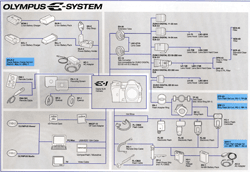
E1 system chart 2003 |
The remainder of the E system is devoted to a substantial choice of flashguns, cables and a power grip, a selection of power packs – an essential accessory for what is a picture-taking computer, focusing screens (2) and eye-cups, soft case, filters and a selection of software for image manipulation. The M[OM] system seems to go on forever with an opening offering of over 200 system pieces in 1972. As said earlier straight comparison is not possible, the technological advancements make the two cameras as different as chalk and cheese. But the question still remains – will the E System assume the mantle of OM? In some ways there is no choice as OM is no more. This aside the answer is probably yes but there are certain other issues that need to be resolved before I’d invest in such a system. The first is that of CCD resolution. The E1 has a CCD of 5.5 million pixels – effective 5 million. What happens when the next generation of CCD arrive? Will the current argument from Olympus that it is not the number of pixels that matters, rather the way their information is transferred to memory, still hold good? Perhaps the next advance might be an interchangeable and upgradeable CCD? Now that would solve a lot of concerns. Finally I have to say that as a Camedia 4040 user I can’t really fault it and my only gripe is that of built in obsolescence. No sooner have you bought it than it’s on special offer somewhere. However this is a somewhat jaded view and applies to all things ‘digital’ and, I suppose, represents the price of progress. Let’s review the E1’s combination of selling points: (1) A larger CCD with an aspect ratio of 4/3rds configured to be an ‘open’ system thus allowing other makers digital lenses to fit: (2) A new method of converting the light signals to data providing a higher degree of accuracy: (3) A special highly sophisticated dust-free system built in: (4) A series of specially designed Zuiko Digital lenses. The M1’s combination of selling points was: (1) A new and fresh approach to 35mm SLR design: (2) Small, lightweight, rugged and beautifully engineered: (3) Reduced noise and vibration, TTL open aperture metering and interchangeable focusing screens: (4) By any standard an impressive line up of lenses & accessories. The object of this article is to draw parallels between the promises made by the M[OM] and E system as it hit the market place. The one certainty we know is that the M[OM] system was a huge success and long-lived, just short of three decades and a difficult act to follow. The M1 was built and developed in a comparatively stable period when computers were used to help design machines and not become them. The E1 is the next generation of machines built against a different set of technological advances and expectations. It is difficult to imagine the E1 concept/system being here in 2032 and probably unreasonable to contemplate it. Having said all that - would you like one? UK Prices: Body only £1408 Standard Zoom 14~54 [28~108 equiv.] F2.8~3.5 = £410 4x Zoom 50~200 [100~400 equiv.] F2.8~3.5 = £780 Macro 50mm [100mm equiv.] F2.0 = £390 Tele 300mm [600mm equiv.] F2.8 = £5380 Tele Converter x 1.4 = £350 FL50 Flash = £350 Flash control = £285 Ring Flash = £212 Battery pack = £60 Charger = £120 2005 notation:- The E system has recently been extended by additional lenses (and more promised), FL-36 flash, additional system accessories and a second body - the E-300. Prices have fallen considerably, except the high end Zuiko digital lenses that remain ludicrously expensive. (E-300 currently £599 in UK.) Will it assume the mantle of OM? Personally, and speaking as an E-1 owner, I doubt it. I cannot see this system reaching anything like those dizzy M/OM heights. It is a capable camera; not perfect and already needing a technology upgrade, but with many very nice touches. As an Olympus devotee I wish it every success, though I do harbour some doubts.
|
|
HOME |
INTRO |
BOOKS |
OLYMPUS CIRCLE |
QUEST |
TOC MEMBERS |
GALLERIES
|
| Posted 26/Feb/2005 14:04 | Copyright © 2004 John Foster |